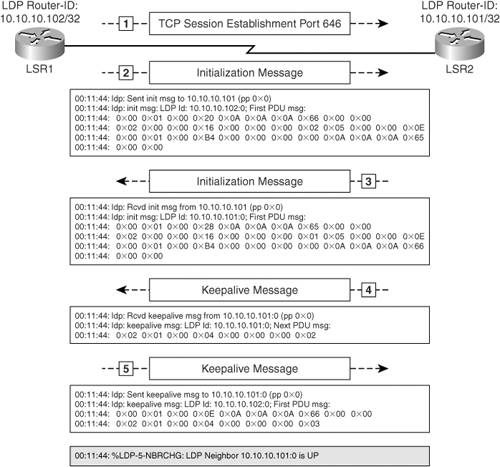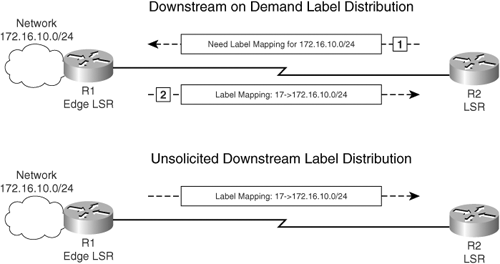MPLS Operation
The implementation of MPLS for data forwarding involves the following four steps:
|
1. |
MPLS label assignment (per LSR) |
|
2. |
MPLS LDP or TDP session establishment (between LSRs/ELSRs) |
|
3. |
MPLS label distribution (using a label distribution protocol) |
|
4. |
MPLS label retention |
MPLS operation typically involves adjacent LSR's forming an LDP session, assigning local labels to destination prefixes and exchanging these labels over established LDP sessions. Upon completion of label exchange between adjacent LSRs, the control and data structures of MPLS, namely FIB, LIB, and LFIB, are populated, and the router is ready to forward data plane information based on label values.
MPLS Label Assignment
A label is assigned to IP networks reachable by a router and then imposed on data packets forwarded to those IP networks. IP routing protocols advertise reachability to destination networks. The same process needs to be implemented for routers or devices that are part of the MPLS domain to learn about the labels assigned to destination networks by neighboring routers. The label distribution protocol (LDP or TDP) assigns and exchanges labels between adjacent LSRs in an MPLS domain following session establishment. As previously mentioned, labels can be assigned either globally (per router) or per interface on a router.
LDP Session Establishment
Following label assignment on a router, these labels are distributed among directly connected LSRs if the interfaces between them are enabled for MPLS forwarding. This is done either by using LDP or tag distribution protocol (TDP). TDP is deprecated and, by default, LDP is the label distribution protocol. The command mpls label protocol {ldp | tdp} is configured only if LDP is not the default label distribution protocol or if you are reverting from LDP to TDP. The command can be configured in global and interface configuration mode. The interface configuration command will, however, override the global configuration.
TDP and LDP function the same way but are not interoperable. It is important to note that when Cisco routers are in use, the default protocol that is running on an MPLS-enabled interface is dependent on the version of IOS running on the device; care must be taken when configuring Cisco routers in a multivendor environment. TDP uses TCP port 711 and LDP uses TCP port 646. A router might use both TDP and LDP on the same interface to enable dynamic formation of LDP or TDP peers depending on the protocol running on the interface of the peering MPLS neighbor. LDP is defined in RFC 3036 and is implemented predominantly between adjacent peers (adjacencies as defined by the IGP). In some cases, LDP sessions can also be configured between nonadjacent peers, where it is called a directed LDP session, which is covered in more detail in Chapters 11 and 12.
There are four categories of LDP messages:
- Discovery messages – Announce and sustain an LSR's presence in the network
- Session messages – Establish, upkeep, and tear down sessions between LSRs
- Advertisement messages – Advertise label mappings to FECs
- Notification messages – Signal errors
Figure 1-10. LDP Session Establishment

All LDP messages follow the type, length, value (TLV) format. LDP uses TCP port 646, and the LSR with the higher LDP router ID opens a connection to port 646 of another LSR:
- LDP sessions are initiated when an LSR sends periodic hellos (using UDP multicast on 224.0.0.2) on interfaces enabled for MPLS forwarding. If another LSR is connected to that interface (and the interface enabled for MPLS), the directly connected LSR attempts to establish a session with the source of the LDP hello messages. The LSR with the higher LDP router ID is the active LSR. The active LSR attempts to open a TCP connection with the passive LSR (LSR with a lower router ID) on TCP port 646 (LDP).
- The active LSR then sends an initialization message to the passive LSR, which contains information such as the session keepalive time, label distribution method, max PDU length, and receiver's LDP ID, and if loop detection is enabled.
- The passive LDP LSR responds with an initialization message if the parameters are acceptable. If parameters are not acceptable, the passive LDP LSR sends an error notification message.
- Passive LSR sends keepalive message to the active LSR after sending an initialization message.
- The active LSR sends keepalive to the passive LDP LSR, and the LDP session comes up. At this juncture, label-FEC mappings can be exchanged between the LSRs.
MPLS Label Distribution with LDP
In an MPLS domain running LDP, a label is assigned to a destination prefix found in the FIB, and it is distributed to upstream neighbors in the MPLS domain after session establishment. The labels that are of local significance on the router are exchanged with adjacent LSRs during label distribution. Label binding of a specific prefix to a local label and a next-hop label (received from downstream LSR) is then stored in the LFIB and LIB structures. The label distribution methods used in MPLS are as follows:
- Downstream on demand – This mode of label distribution allows an LSR to explicitly request from its downstream next-hop router a label mapping to a particular destination prefix and is thus known as downstream on demand label distribution.
- Unsolicited downstream – This mode of label distribution allows an LSR to distribute bindings to upstream LSRs that have not explicitly requested them and is referred to as unsolicited downstream label distribution.
Figure 1-11 depicts the two modes of label distribution between R1 (Edge LSR) and R2 (LSR). In the downstream-on-demand distribution process, LSR R2 requests a label for the destination 172.16.10.0. R1 replies with a label mapping of label 17 for 172.16.10.0. In the unsolicited downstream distribution process, R1 does not wait for a request for a label mapping for prefix 172.16.10.0 but sends the label mapping information to the upstream LSR R2.
Figure 1-11. Unsolicited Downstream Versus Downstream on Demand

MPLS Label Retention
If an LSR supports liberal label retention mode, it maintains the bindings between a label and a destination prefix, which are received from downstream LSRs that might not be the next hop for that destination. If an LSR supports conservative label retention mode, it discards bindings received from downstream LSRs that are not next-hop routers for a destination prefix. Therefore, with liberal retention mode, an LSR can almost immediately start forwarding labeled packets after IGP convergence, where the numbers of labels maintained for a particular destination are large, thus consuming memory. With conservative label retention, the labels maintained are labels from the confirmed LDP or TDP next-hop neighbors, thus consuming minimal memory.
MPLS Overview
- MPLS Overview
- Unicast IP Forwarding in Traditional IP Networks
- Overview of MPLS Forwarding
- MPLS Terminology
- MPLS Control and Data Plane Components
- MPLS Operation
- Special Outgoing Label Types
- Penultimate Hop Popping
- Frame-Mode MPLS
- Cell-Mode MPLS
Basic MPLS Configuration
- Basic MPLS Configuration
- Frame-Mode MPLS Configuration and Verification
- Cell-Mode MPLS over ATM Overview, Configuration, and Verification
- Command Reference
Basic MPLS VPN Overview and Configuration
- Basic MPLS VPN Overview and Configuration
- VPN Categories
- MPLS VPN Architecture and Terminology
- MPLS VPN Routing Model
- MPLS VPN Basic Configuration
- Outbound Route Filters
- Command Reference
PE-CE Routing Protocol-Static and RIP
- PE-CE Routing Protocol-Static and RIP
- Static PE-CE Routing Overview, Configuration, and Verification
- Static PE-CE Routing Command Reference
- RIPv2 PE-CE Routing Overview, Configuration, and Verification
- RIPv1 PE-CE Routing Configuration and Verification
- RIP PE-CE Routing Command Reference
PE-CE Routing Protocol-OSPF and EIGRP
- PE-CE Routing Protocol-OSPF and EIGRP
- OSPF PE-CE Routing Protocol Overview, Configuration and Verification
- EIGRP PE-CE Routing Protocol Overview, Configuration, and Verification
Implementing BGP in MPLS VPNs
- Implementing BGP in MPLS VPNs
- BGP PE-CE Routing Protocol Overview, Configuration, and Verification
- Implementing Route-Reflectors in MPLS VPN Networks
- Case Study-Hub and Spoke MPLS VPN Network Using BGP PE-CE Routing for Sites Using Unique AS Numbers
- Case Study-Hub and Spoke MPLS VPN Network with Sites Using Same AS Numbers
- Command Reference
Inter-Provider VPNs
- Inter-Provider VPNs
- Overview of Inter-Provider VPNs
- Option 1: Inter-Provider VPN Using Back-to-Back VRF Method
- Option 2: Inter-Provider VPNs Using ASBR-to-ASBR Approach
- Option 3: Multi-Hop MP-eBGP Between RR and eBGP Between ASBRs
- Option 4: Non-VPN Transit Provider
- Case Study-Inter-AS Implementing Route-Reflector and BGP Confederation in Provider Networks
- Case Study-Multi-Homed Inter-AS Provider Network
- Command Reference
Carrier Supporting Carriers
- Carrier Supporting Carriers
- Carrier Supporting Carriers Overview
- Deployment Scenarios with CSC Architecture
- CSC Architecture Benefits
- Command Reference
MPLS Traffic Engineering
- MPLS Traffic Engineering
- TE Basics
- MPLS TE Theory
- Constraint-Based Routing and Operation in MPLS TE
- Configuring MPLS TE
- Command Reference
Implementing VPNs with Layer 2 Tunneling Protocol Version 3
- Implementing VPNs with Layer 2 Tunneling Protocol Version 3
- L2TPv3 Overview
- Configuring L2TPv3 Tunnels for Layer 2 VPN
- Configuring L2TPv3 Static Tunnels
- Configuring L2TPv3 Dynamic Tunnels
- Implementing Layer 3 VPNs over L2TPv3 Tunnels
- Command Reference
Any Transport over MPLS (AToM)
- Any Transport over MPLS (AToM)
- Introduction to Layer 2 VPNs
- Implementing AToM for Like to Like Circuits
- L2 VPN-Any to Any Interworking
- Local Switching
- Command Reference
Virtual Private LAN Service (VPLS)
- Virtual Private LAN Service (VPLS)
- VPLS Overview
- VPLS Topology-Single PE or Direct Attachment
- Hierarchical VPLS-Distributed PE Architecture
- Command Reference
Implementing Quality of Service in MPLS Networks
- Implementing Quality of Service in MPLS Networks
- Introduction to QoS-Classification and Marking
- MPLS QoS Implementation
- MPLS QoS Operating Modes
- Modular QoS CLI: Configuration of QoS on Cisco Routers
- Configuration and Implementation of MPLS QoS in Uniform Mode and Short Pipe Mode Operation
- Implementing MPLS QoS for Layer 2 VPN Implementations
- Command Reference
MPLS Features and Case Studies
- MPLS Features and Case Studies
- Case Study 1: Implementing Multicast Support for MPLS VPNs
- Case Study 2: Implementing Multi-VRF CE, VRF Selection Using Source IP Address, VRF Selection Using Policy-Based Routing, NAT and HSRP Support in MPLS VPN, and Multicast VPN Support over Multi-VRF CE
- Case Study 3: Implementing Layer 2 VPNs over Inter-AS Topologies Using Layer 2 VPN Pseudo-Wire Switching
- Case Study 4: Implementing Layer 3 VPNs over Layer 2 VPN Topologies and Providing L2 VPN Redundancy
- Case Study 5: Implementing Dynamic Layer 3 VPNs Using mGRE Tunnels
- Case Study 6: Implementing Class-Based Tunnel Selection with MPLS Traffic Engineering
- Case Study 7: Implementing Hub and Spoke Topologies with OSPF
- Case Study 8: Implementing Hub and Spoke Topologies with EIGRP
- Case Study 9: Implementing VPLS Services with the GSR 12000 Series
- Case Study 10: BGP Site of Origin
- Command Reference
EAN: 2147483647
Pages: 130
